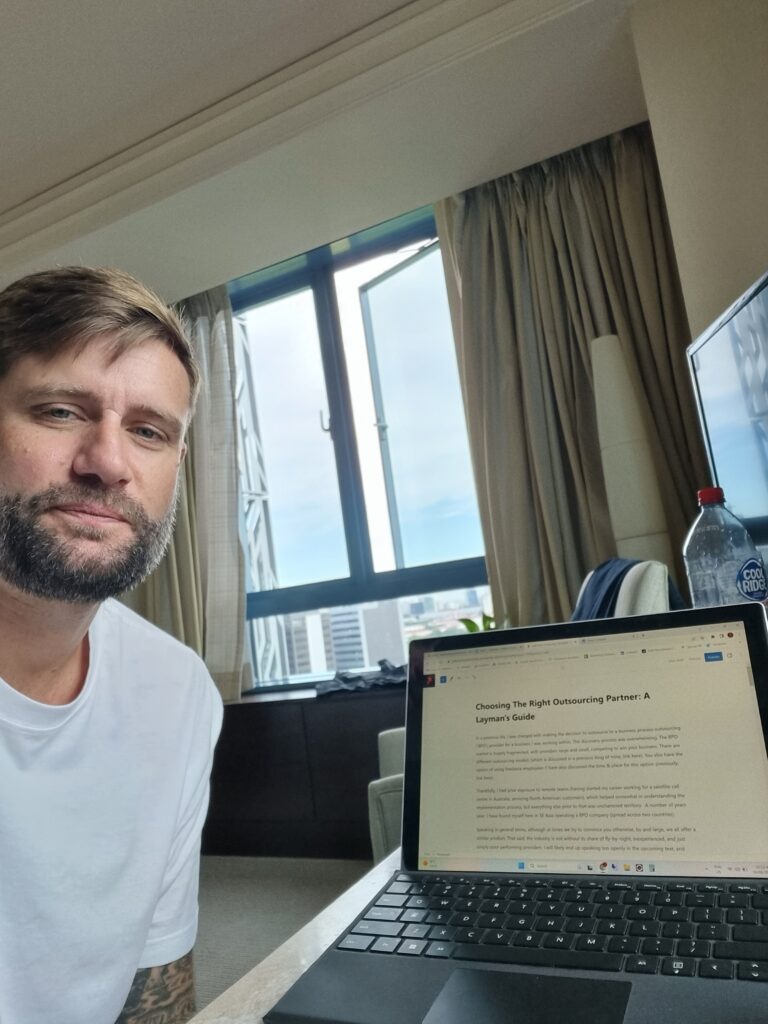

In a previous life, I was charged with making the decision to outsource to a business process outsourcing ('BPO') provider for a business I was working within. The discovery process was overwhelming. The BPO market is hugely fragmented, with providers large and small, competing to win customer accounts. There are different outsourcing models (offshoring, outsourcing, and co-sourcing). You also have the option of using freelance employees (I have previously discussed the time & place for both options, link here).
Thankfully, I had prior exposure to remote teams (having started my career working for a satellite call centre in Australia, servicing North American customers), which helped somewhat in understanding the implementation process, but everything else prior to that was unchartered territory. A number of years later, I have found myself here in SE Asia operating a BPO company (spread across two countries - the Philippines and Indonesia).

Speaking in general terms, although at times we try to convince you otherwise, by and large, we all offer a similar product. That said, the industry is not without its share of fly-by-night, inexperienced, and just plain poor performing providers.
I was cognisant when writing this, as not to constantly be pitching to you how great we are here at Platinum Outsourcing (I can do this over a discovery call if you like haha), but rather an honest perspective on what we do, what the norms are, and what I believe to be some relatively clear red flags when you decide to go to market (and start your discussions with a BPO provider). Ultimately, a rising tide lifts all boats - we want the outsourcing industry here to continue to thrive, it has and continues to create a burgeoning middle class (particularly in the Philippines) and I hope this guide helps you in someway on your journey into outsourcing; what is a tried and tested, viable strategy, for businesses globally.
Note that this particularly blog is my personal perspective, and based on my lived experience.
I have broken the blog down into the key areas I believe are most important to understand and consider when you embark on your journey of building a remote team. I have given some short insights into how we do things, how others might do it, and the what I believe are some red flags to keep an eye out for.
As with any other, contracts can vary widely in our industry. The standard items you should be looking for in a service agreement between you and your BPO provider are the monthly costs, payment terms, and the cessation clause (as it applies to both parties). Platinum Outsourcing have a standard 60 day cessation clause, occasionally this may be extended to 90 days (or in some rare cases shortened to <60 days) . Our team are employed full time, so if a partner exits, we need to give ourselves time to arrange a suitable redeployment for our employee, so there is a balance that needs to be achieved between not locking you down for months on end, but also giving our employees continuity of employment (and job security).
Red Flags:
Just a short note on the onboarding process to kick this section off. We like others, advertise that we can 'onboard quickly'. No new partner wants to wait around months on end to find talent, and half the time the reason we are talking with prospective customers is because they cannot mobilise talent onshore. With that said, finding the right fit (both in a technical and team fit capacity) takes time. If you go through the recruitment process with a BPO partner, and within 5 minutes of receiving the job description they start firing you off resumes to you (that don't even seem to match the JD) - run!
For a non technical, customer support type role, the talent pool in SE Asia is large, and they are a somewhat transient working population (meaning they are always looking for new opportunities) - rule of thumb, minimum 2-4 weeks for us to find, prescreen, and get them started (keep in mind if they are currently employed, it immediately jumps to a minimum of 30 days, as that's the standard notice period the have to provide their current employer).
For technical type roles, think developers, engineers etc - minimum 4 weeks, more likely 6 weeks unless we get lucky on timing (and the right candidate is looking as we are searching). When I say 6 weeks, I mean from the moment you say 'go' to the time they first login and start working for you.
We only recently implemented an onboarding fee, our first years of operation we didn't have an onboarding fee and just took the hit for any costs associated with recruiting, procuring equipment and onboarding. We now charge a once off (per employee), $395AUD onboarding fee, it forms part of your first invoice. It helps us cover the cost of the aforementioned items. I don't think there are many providers out there as of today who don't charge some form of onboarding fee (I could be wrong though), I do know that our $395AUD charge is on the lower end of the scale (as compared to others that also have one). I wouldn't be opposed in paying slightly more than that (if it were me), that said, anything above $500AUD I would start asking questions.
In the interests of transparency, if you require non-standard equipment (say you need a MacBook for an iOS developer), there would be additional charges above and beyond our onboarding fee (to up-spec) to that equipment. Don't need to go into a huge amount of detail here, in our case all this info is provided to you well before we even start working together. The learning here is that you should be getting this information upfront and without asking (or finding out in a roundabout way).
Note - I wouldn't be happy if I were asked to pay anything costs upfront, meaning before my remote team member/s started work.
Red Flags:
First thing to understand about pricing is that generally speaking you will come across two fee structures in our industry. One where the BPO company will tell you their $ margin, and one where they will not. Meaning you cannot always be sure what % of the monthly fee goes to the BPO, and what % goes to employment costs. This is not always a red flag, and admittedly, we ourselves only recently switched from quoting a monthly total, to breaking that down (for new clients) into two components (our fee, and the employment costs). I feel the optics of breaking the fee down make it more palatable for new clients, they can see right away that we are not pocketing obscene gross margin, they know our team receive the lions share, and there is a degree of transparency.
Our fee is reviewed formally every 12 months (from your agreements anniversary date), your teams salary is reviewed every 12 months (financial year). I do not have a huge amount of insights into what our competitors do in terms of the review process - sorry!
Payment terms (as far as I am aware will be 28 days for nearly everyone).
Red Flags:

The facilities provided by any BPO provider are really important to your partnership. You want your remote team to be working in a comfortable environment, the same way any onshore team would. Some of our competitors go to market as a pure play remote offer, meaning they do not have a physical office, and the teams they build here all work remotely - there is nothing wrong with this, but it should be clear this is their offering in both their marketing, and when you are speaking with them. It should never be something you discover after engagement.
Our Indonesian team is almost exclusively WFO, and our Philippines team is split 60/40 (60% working WFH/hybrid, and the remaining 40% of the team working permanently from our offices here in Manila). As a general rule, we like highly transactional roles (i.e. customer support) in the office, as these positions tend to require a higher degree of managerial oversight, and the working population in this employment segment tends to be accustomed to working from an office anyway. Our developers, creatives and alike will almost exclusively work remotely, and this is what the employment market demands - if you want the best talent, they tend to always want to work remotely.
If the provider does have a facility, I would want to see what it looks like, understand where its located, and in respect to both WFO/WFH, it would be a good idea to understand what redundancies they have in place regarding power outages, internet downtime etc, as an example do they have generators for power outages, and secondary connectivity options if their primary ISP fails for some reason. These are good things to think and enquire of those you are talking with.
Red Flags:
There are lots of well documented evidence on why keeping your employees happy is important; we won't bang on about that here. What you want to see from a BPO provider is:
Outside of that, check the red flags below.
Red Flags:
To summarise, we (Platinum Outsourcing) are one of many providers at your disposal, once you confirm there are no red flags, it really comes down to who you feel most comfortable working with, and ensuring they are the right fit for you and your team. I am happy to answer any questions you might have or to act as a sounding board if you are seeking advice, if it leads to a partnership, great! If it doesn't, that's OK also.
You can find me on LinkedIn at this link.
Thanks for stopping by.
Dale.